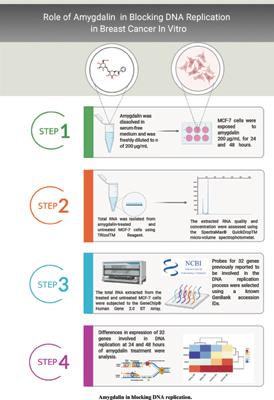Current Pharmaceutical Biotechnology ( IF 2.8 ) Pub Date : 2021-09-30 , DOI: 10.2174/1389201022666210203123803 Sarah Albogami 1 , Alaa Alnefaie 1

|
Background: Amygdalin has anticancer benefits because of its active component, hydrocyanic acid. However, the underlying molecular mechanism is unclear.
Objective: This study aimed to investigate the molecular mechanism by which amygdalin exerts antiproliferative effects in the human Michigan Cancer Foundation-7 (MCF-7) breast cancer cell line.
Methods: MCF-7 cells were exposed to amygdalin at a particular IC50 value for 24 and 48 hours and compared to non-treated cells. An Affymetrix whole-transcript expression array was used to analyze the expression of 32 genes related to DNA replication.
Results: Among the 32 genes, amygdalin downregulated the expression of 16 genes and 19 genes by >1.5-fold at 24 and 48 hours, respectively. At 24 hours, the downregulated genes from the DNA polymerase α-primase complex were POLA1, POLA2, PRIM1, and PRIM2; DNA polymerase δ complex: POLD3; DNA polymerase ε complex: POLE4, Minichromosome Maintenance protein (MCM) complex (helicase): MCM2, MCM3, MCM4, MCM6, and MCM7; clamp and clamp loader: PCNA; nuclease: FEN1; and DNA ligase: LIG1. At 48 hours, the downregulated genes from the DNA polymerase α-primase complex were POLA1, POLA2, and PRIM1; DNA polymerase δ complex: POLD3; DNA polymerase ε complex: POLE and POLE2; MCM complex (helicase): MCM2, MCM3, MCM4, MCM5, MCM6, and MCM7; clamp and clamp loader: PCNA, RFC2, and RFC3; RNase H: RNASEH2A; nucleases: DNA2 and FEN1; and DNA ligase: LIG1.
Conclusion: Amygdalin treatment caused downregulation of several genes that play critical roles in DNA replication in the MCF-7 cell line. Thus, it might be useful as an anticancer agent.
中文翻译:

苦杏仁苷在体外阻断乳腺癌 DNA 复制中的作用
背景:苦杏仁苷具有抗癌功效,因为它的活性成分是氢氰酸。然而,潜在的分子机制尚不清楚。
目的:本研究旨在探讨苦杏仁苷在人类密歇根癌症基金会-7 (MCF-7) 乳腺癌细胞系中发挥抗增殖作用的分子机制。
方法:将 MCF-7 细胞暴露于特定 IC 50值的苦杏仁苷24 和 48 小时,并与未处理的细胞进行比较。使用 Affymetrix 全转录表达阵列来分析 32 个与 DNA 复制相关的基因的表达。
结果:在 32 个基因中,苦杏仁苷分别在 24 和 48 小时下调了 16 个基因和 19 个基因的表达 > 1.5 倍。在 24 小时时,DNA 聚合酶 α-primase 复合物的下调基因为 POLA1、POLA2、PRIM1 和 PRIM2;DNA聚合酶δ复合物:POLD3;DNA 聚合酶 ε 复合物:POLE4、微染色体维持蛋白 (MCM) 复合物(解旋酶):MCM2、MCM3、MCM4、MCM6 和 MCM7;夹具和夹具装载器:PCNA;核酸酶:FEN1;和 DNA 连接酶:LIG1。在 48 小时时,DNA 聚合酶 α-引物酶复合物的下调基因为 POLA1、POLA2 和 PRIM1;DNA聚合酶δ复合物:POLD3;DNA聚合酶ε复合物:POLE和POLE2;MCM复合体(解旋酶):MCM2、MCM3、MCM4、MCM5、MCM6和MCM7;夹具和夹具加载器:PCNA、RFC2 和 RFC3;RNase H:RNASEH2A;核酸酶:DNA2 和 FEN1;和 DNA 连接酶:LIG1。
结论:苦杏仁苷处理导致在 MCF-7 细胞系中在 DNA 复制中起关键作用的几个基因的下调。因此,它可能用作抗癌剂。

























 京公网安备 11010802027423号
京公网安备 11010802027423号